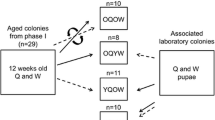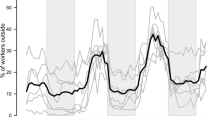Abstract
Age-related behavioural change of individually marked and known-age workers of a colony ofDiacamma sp. was observed through entire ant lives in the laboratory for more than a year. Although typical age polyethism was observed, activity of inside and outside tasks, life span, or time schedule of behavioural change varied considerably among workers. Idiosyncrasies in age-related behavioural change was detected among workers that eclosed on the same day. Cluster analyses revealed that individual patterns of behavioural change tended to be different when eclosion dates were far apart. This suggests that most workers change their behaviour flexibly. Thus, there is little effect of idiosyncrasy on colony response to changes in colony condition.
Similar content being viewed by others
References
Altmann, J. 1974 Observational study of behaviours: sampling methods.Behaviour 49: 227–267.
Calabi, P. & R. Rosengaus 1988 Interindividual differences based on behaviour transition probabilities in the antCamponotus sericeiventris. In: R.L. Jeanne (ed.)Interindividual Behavioural Variability in Social Insects. pp. 61–90. Westview press, Boulder.
Calabi, P. & J.F.A. Traniello 1989 Behavioural flexibility in age castes of the antPheidole dentata.J. Insect Behav. 2: 663–677.
Calabi, P. & J.F.A. Traniello 1989 Social organization in the antPheidole dentata. Physical and temporal caste ratios lack ecological correlates.Behav. Ecol. Sociobiol. 24: 69–74.
Champalbert, A. & J.-P. Lachaud 1990 Existence of a sensitive period during the ontogenesis of social behaviour in a primitive ant.Anim. Behav. 39: 850–859.
Corbara, B., J.-P. Lachaud & D. Fresneau 1989 Individual variability, social structure and division of labour in the ponerine antEctatomma rudium roger (Hymenoptera, Formicidae).Ethology 82: 89–100.
Deneubourg, J.-L., S. Goss, J.M. Pasteels, D. Fresneau & J.-P. Lachaud 1987 Self-organization mechanism in ant societies (II): larning in foraging and division of labor In: J.M. Pasteels & J.-L. Deneubourg (ed.)From Individual to Collective Behaviour in Social Insects. pp. 177–196. Birkhäuser Verlag, Basel.
Franks, N.R. & C. Tofts 1994 Foraging for work: how tasks allocate workers.Anim. Behav. 48: 470–472.
Fresneau, D., J. Garcia Perez & P. Jaisson 1982 Evolution of polyethism in ants: observational results and theories In: P. Jaisson (ed.)Social Insects in the Tropics. pp. 129–155. Presses de l'Univ. Paris-Nord, Paris.
Fresneau, D. & P. Dupuy 1988 A study of polyethism in a ponerine ant:Neoponeara apicalis (Hymenoptera, Formicidae).Anim. Behav. 36: 1389–1399.
Fukumoto, Y., T. Abe & A. Taki 1989 A novel form of colony organization in the “queenless” antDiacamma rugosum.Physiol. Ecol. Japan 26: 55–61.
Gadagkar, R. & N.V. Joshi 1984 Social organization in the Indian waspRopalidia cyathiformis (Fab.) (Hymenoptera: Vespidae).Z. Tierpsychol. 64: 15–32.
Gordon, D.M. 1987 Group-level dynamics in harvester ants: young colonies and the role of patrolling.Anim. Behav. 35: 833–843.
Hölldobler, B. & E.O. Wilson 1990 The Ants. The Belknap Press of Harvard University Press, Cambridge.
Huang, Z.-Y. & G.E. Robinson 1992 Honeybee colony integration: Worker-worker interaction mediate hormonally regulated plasticity in division of labour.Proc. Natl. Acad. Sci. USA 89: 11726–11729.
Jaisson, P., D. Fresneau & J.-P. Lachaud 1988 Individual traits of social behaviour in ants In: R.L. Jeanne (ed.)Interindividual Behavioural Variability in Social Insects. pp. 1–51. Westview Press, Boulder, Colorado.
Lenoir, A. 1987 Factors determining polyethism in social insects In: J.M. Pasteels & J.-L. Deneubourg (ed.)From Individual to Collective Behaviour in Social Insects. pp. 219–240. Birkhäuser Verlag, Basel.
Moffet, M.W. 1986 Evidence of workers serving as queens in the genusDiacamma (Hymenoptera: Formicidae).Psyche 93: 151–152.
Ohtani, T. 1993 Division of labor and individuality in honeybees. In: T. Inoue & S. Yamane (eds.)Evolution of insect societies. pp. 93–146. Hakuhinsha, Tokyo (in Japanese).
Otto, D. 1958 Über die Arbeitsteilung im Staate vonFormica rufa rufopratensis minor Gössow und ihre werhaltersphysiologischen Grudlagen: ein Beitrag zur Biologie der RotenWaldameise.Wissensch. Abhadl. Deutch. Akad. Landwirtsch. Berlin 30: 1–169.
Peeters, C. & R.M. Crewe 1984 Insemination controls the reproductive division of labour in a ponerine ant.Naturwiss. 71: 50–51.
Peeters, C. & J.P.J. Billen 1991 A novel exocrine gland inside the thoracic appendages (‘gemmae’) of the queenless andDiacamma australe.Experientia 47: 229–231.
Retana, J. & X. Cerda 1990 Social organization ofCataglyphis cursor ant colonies (Hymenoptera, Formicidae): inter-, and intraspecific comparisons.Ethology 84: 105–122.
Retana, J. & X. Cerda 1991 Behavioural variability and development ofCataglyphis cursor and workers (Hymenoptera, Formicidae).Ethology 89: 275–286.
Robinson, G.E. 1992 Regulation of division of labor in insect societies.Ann. Rev. Entomol. 37: 637–665.
Robinson, G.E., R.E. Page Jr, & Z.-Y. Huang 1994 Temporal polyethism in social insects is a developmental process.Anim. Behav. 48: 467–469.
Seeley, T.D. 1982 Adaptive significance of the age polyethism schedule in honeybee colonies.Behav. Ecol. Sociobiol. 11: 287–293.
Seeley, T.D. & S.A. Kolmes 1991 Age polyethism for hive duties in honey bees—illusion or reality?Ethology 87: 284–297.
Sekiguchi, K. & S.F. Sakagami 1966 Structure of foraging population and related problems in the honeybee, with consideration on the devision of labour in bee colonies.Hokkaido Natl. Agric. Exp. Stn. Rep. 69: 1–65.
Sendova-Franks, A. & N.A. Franks 1993 Task allocation in ant colonies within variable environments (a study of temporal polyethism: experimental).Bull. math. Biol. 55: 75–96.
Tofts, C. 1993 Algorithms for task allocation in ants. (a study of temporal polyethsim: theory).Bull. math. Biol. 55: 891–918.
Traniello, J.F.A. 1978 Caste in a primitive ant: absence of age polyethism inAmblyopone.Science 202: 770–772.
Villet, M.H. 1990 Division of labour in the matable antMegaponera foetens (Fabr.) (Hymenoptera Formicidae).Ethol. Ecol. & Evol. 2: 397–417.
Villet, M.H. 1991 Social differentiation and division of labour in the queenless antPlatythyrea scultzei Forel 1910 (Hymenoptera Formicidae).Trop. Zool. 4: 13–29.
Ward, J.H. 1963 Hierarchical grouping to optimize an object function.J. Amer. Stat. Assoc. 58: 236–244.
Wheeler, W.M. & J.W. Chapman 1922 The mating ofDiacamma.Psyche 29: 203–211.
Wilson, E.O. 1976 Behavioural discretization and the number of castes in an ant species.Behav. Ecol. Sociobiol. 1: 141–154.
Author information
Authors and Affiliations
About this article
Cite this article
Nakata, K. Age polyethism, idiosyncrasy and behavioural flexibility in the queenless ponerine ant,Diacamma sp.. J. Ethol. 13, 113–123 (1995). https://doi.org/10.1007/BF02352570
Received:
Accepted:
Issue Date:
DOI: https://doi.org/10.1007/BF02352570




